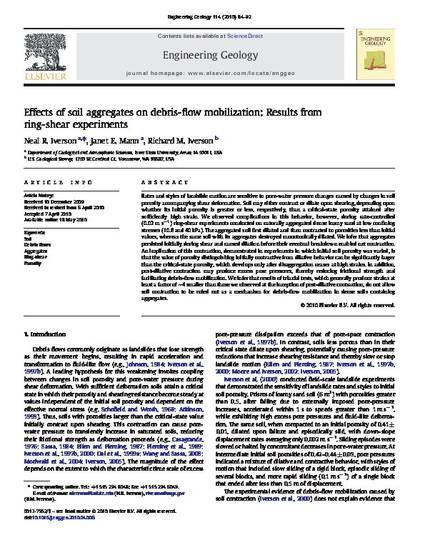
Rates and styles of landslide motion are sensitive to pore-water pressure changes caused by changes in soil porosity accompanying shear deformation. Soil may either contract or dilate upon shearing, depending upon whether its initial porosity is greater or less, respectively, than a critical-state porosity attained after sufficiently high strain. We observed complications in this behavior, however, during rate-controlled (0.02 m s− 1) ring-shear experiments conducted on naturally aggregated dense loamy sand at low confining stresses (10.6 and 40 kPa). The aggregated soil first dilated and then contracted to porosities less than initial values, whereas the same soil with its aggregates destroyed monotonically dilated. We infer that aggregates persisted initially during shear and caused dilation before their eventual breakdown enabled net contraction. An implication of this contraction, demonstrated in experiments in which initial soil porosity was varied, is that the value of porosity distinguishing initially contractive from dilative behavior can be significantly larger than the critical-state porosity, which develops only after disaggregation ceases at high strains. In addition, post-dilative contraction may produce excess pore pressures, thereby reducing frictional strength and facilitating debris-flow mobilization. We infer that results of triaxial tests, which generally produce strains at least a factor of ∼ 4 smaller than those we observed at the inception of post-dilative contraction, do not allow soil contraction to be ruled out as a mechanism for debris-flow mobilization in dense soils containing aggregates.
Available at: http://works.bepress.com/neal-iverson/45/

This article is published as Iverson, Neal R., Janet E. Mann, and Richard M. Iverson. "Effects of soil aggregates on debris-flow mobilization: Results from ring-shear experiments." Engineering Geology 114, no. 1-2 (2010): 84-92. DOI: 10.1016/j.enggeo.2010.04.006.